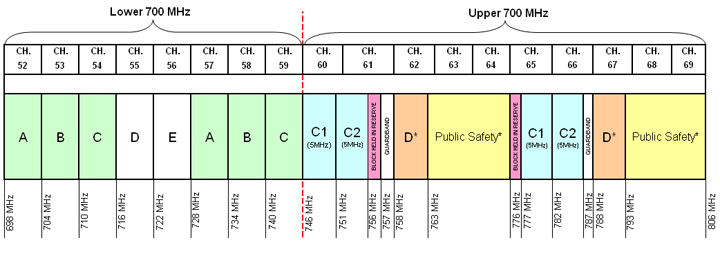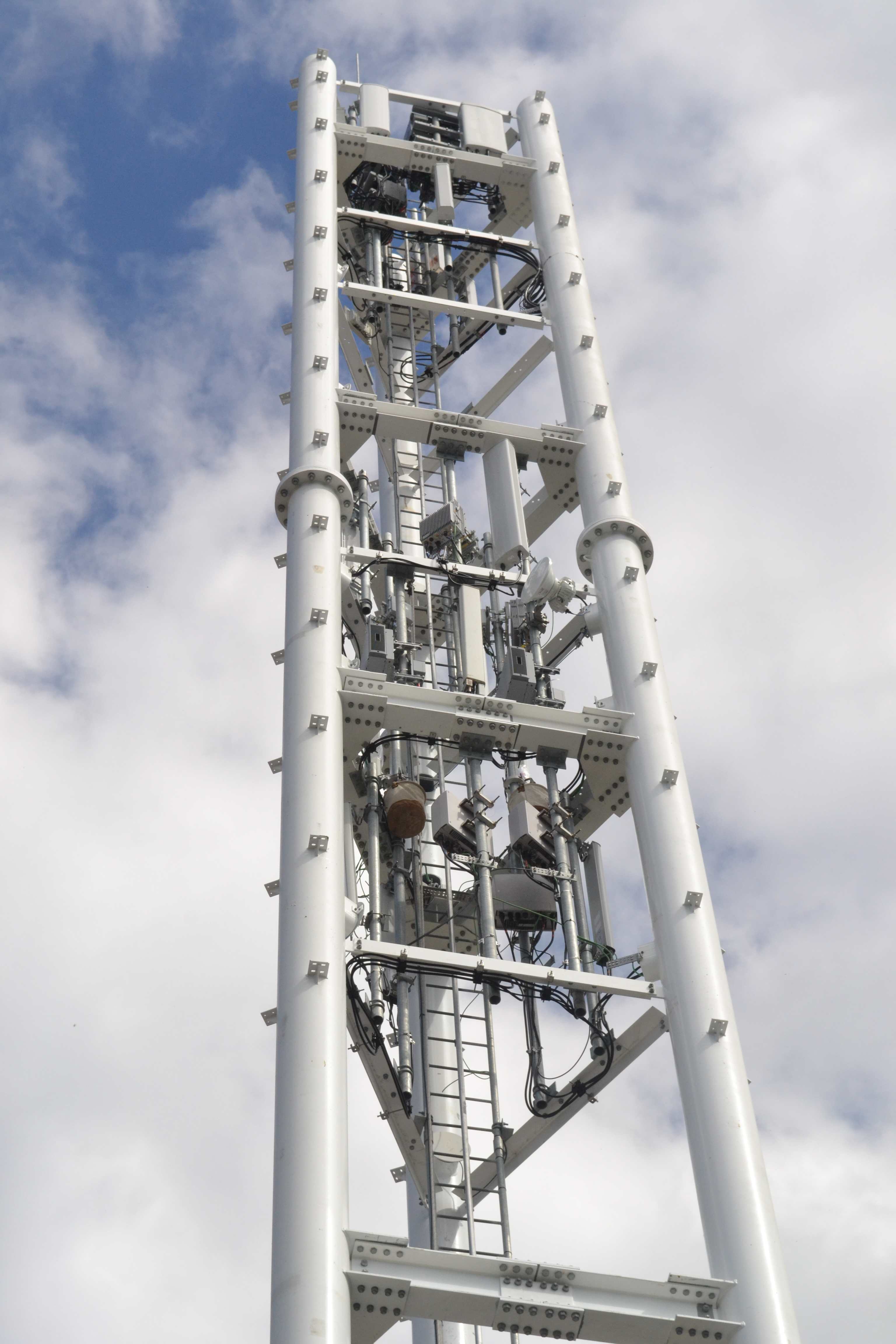Background/Timeline
(Note: CSPR’s Gregory Taylor published an article on the history of spectrum auctions in 2013. An unformatted version of the paper is available here.)
The spectrum auctioned in early 2014 is known as the “digital dividend” — the spectrum freed by Canada’s switch from analogue to digital television broadcasting on September 1, 2011. The United States held their digital dividend auction in 2008, raising over $19 billion dollars (over $16 billion of which came from only two carriers: AT&T and Verizon).
The Canadian Mobile Broadband Services (MBS) / 700 MHz band auction process formally began with an announcement by Industry Canada on November 30, 2010 of a consultation process. As a result of comments received (including a submission by CSPR’s Drs. Taylor & Middleton) and internal decisions, the Policy and Technical Framework was released on March 14, 2011, “which set out Industry Canada’s general policy decisions for both the band 698-806 MHz (known as the 700 MHz band) and the band 2500-2690 MHz (known as the 2500 MHz band).” This consultation helped determine the technical specifications of how the 700 MHz band would be allotted (see below).
From there, a more focused consultation was launched to explore issues, “related to the licensing process, auction format and conditions of licence applicable to the 700 MHz band” on April 25, 2012; this consultation emphasized how the band would be assigned. (CSPR again contributed to the consultation process with a submission.) In addition to consulting about commercial usage of the 700 MHz band, Industry Canada also sought comments about the use of particular parts or “blocks” of the band (the Upper D block and Public Safety Broadband block, PSBB, totalling 10×10 MHz), intended to provide exclusive mobile broadband capability for public safety and first responders. (The parts of the 2500 MHz band not currently owned by Bell and Rogers is scheduled to be auctioned off starting April 14, 2015.)
Industry Canada announced their decisions regarding auction format and rules, the conditions of licence, and licensing process for the 700 MHz band on March 7, 2013, with the auction originally slated to start on November 19, 2013. Since then, Industry Canada has posted a number of ‘Responses to Clarification Questions‘ regarding the 700 MHz Licensing Framework and pushed back the auction start date, which began January 14, 2014 and was completed February 13, 2014.
Please see Industry Canada’s website for a full listing of documents related to the consultation processes and Auction of Spectrum Licences for Mobile Broadband Services (MBS) in the 700 MHz Band.
Auction Participants and Format
Speculation was rampant in the press during the summer months of 2013 that the recent liberalization of foreign investment for small Canadian telecommunication providers might mean the participation of US- or international-based mobile carriers in Canada’s 700MHz auction. The potential arrival of US-based Verizon set off an unprecedented public relations campaign and caused a tremendous rift between the government and industry. However, when the list of provisionally qualified bidders was finally made public, only Canadian participants were in.
Previously, Industry Canada has mainly used a Simultaneous Multiple Round Ascending (SMRA) auction format to award spectrum licences but for the 700 MHz band used the Combinatorial Clock Auction (CCA) format. The CCA format has been used for spectrum licensing by other countries but, generally, for smaller (geographic) ones with licences that were national in coverage, as opposed to Canada’s Tier 2 (regional) licensing for the 700 MHz band. Industry Canada selected the CCA format based on its utilization of “package bids”, to eliminate “the risk that bidders win some but not all of the licences needed for their business case” — in practical terms, it creates the ability to secure a national (Tier 1) licence. Regional carriers that only desired a Tier 2 spectrum licence for their home territory argued the CCA format put them at a disadvantage vis-à-vis national carriers.
Industry Canada indicated they went forward with this decision because of the “distinct” device ecosystem that emerged in the US (see below for further information) and it would result in an “efficient assignment of licences”, which is economist language for maximizing bid prices — the amount of revenue the government stood to raise from auctioning spectrum licences.
The 700 MHz Band Plan
One of the primary areas of consultation for the Canadian 700 MHz Policy and Technical Framework was a determination of how to allot the band. (For further explanation in the difference between allocation, allotment, and assignment, see Canadian Spectrum Inventory.) The options under consideration were harmonization with the band plan that the Federal Communications Commission used for the US 700 MHz auction (held in 2008), a modified version of the US 700 MHz band plan, and the Asia-Pacific Telecommunity (APT) 700 MHz band plan.
Industry Canada went with a slightly modified US 700 MHz band plan, as seen in the image below. The advantages of this plan are cross-border interference with US carriers can be minimized (spectrum waves do not stop at the border) and the US is the only country to have deployed mobile telecommunication services in the 700 MHz band, so there is a device and infrastructure ecosystem already well into development and rollout. Additionally, this band plan reserves specific spectrum blocks for the use of public safety and first responders in Canada, which may permit future radio and transmission equipment of paramedics, firefighters and police to work on both sides of the Canada-US border, an advantage in the event of a natural or man-made disaster and for forest firefighters who work throughout North America.

Canadian 700 MHz band plan.
Source: Policy and Technical Framework , Industry Canada
The disadvantage of this band plan, according to many critics, is that it is an inefficient use of spectrum because the channels are so small (effectively 5×5 MHz) and modern transmission technologies like LTE benefit from wider channels. For comparison, the APT band was divided into a single 45×45 MHz channel, which can still be sub-divided and used by multiple carriers. This could allow for the widest LTE-standard channels of 20×20 MHz. And while there is a current ecosystem for the US 700 MHz band plan, most other countries in the world have committed to the APT band plan (including Mexico) or seem to be moving towards adopting it, meaning it will eventually provide much larger economies of scale. Further, the US ecosystem has not emerged without concerns, as explored below.
Band plans can get into some very technical details but are crucial because they (along with deployed radio access network technologies) help drive device ecosystems, a term that encompasses which mobile phones will work with which carrier. The most prominent Canadian example might be when Apple’s iPhone originally launched in Canada and was available only on Rogers. This is because the iPhone originally only supported GSM-based networks and Bell and TELUS had CDMA-based networks. (They have since partnered to build and run a GSM-based network, using 3G & LTE technology.)
How bands and technologies interact to create device and infrastructure ecosystems is also part of the reason why Canada’s new entrants have not been able to get certain devices for their network, as Canadian carriers have historically accessed the device ecosystem of US-based carriers. As a further example, recent network deployments by T-Mobile in the United States that align with AWS spectrum usage by new entrants means Canadians can now use an unlocked T-Mobile iPhone on WIND’s network.
Spectrum Licences up for Auction
The Canadian 700 MHz auction was often said to possess four “prime” blocks of paired spectrum, which have spectrum for both uplink (sending) and downlink (receiving). These prime blocks were the B and Lower C Block (or just C Block, known in industry terms as the “AT&T blocks”) and the Upper C Blocks (C1 & C2, or the “Verizon blocks”). In addition, there was another paired block (A Block) and two unpaired blocks (D & E Blocks) that were not considered prime.
In the case of the A Block, there is some concern about interference from television broadcasters that have spectrum licences in adjacent frequencies. Television signals are much more powerful than mobile phone signals and could interfere with their operation. There is, though, some dispute regarding interference in this band. Another, perhaps more critical factor, is that the A, B & C Blocks were meant to use the same radio equipment, or “interoperate”. For a combination of technical issues (the risk of interference) and business reasons (anti-competitive behaviour), a new radio standard that only worked for B & C Blocks was devised.
As it was primarily only smaller, regional carriers that had purchased A Block in the US auction, there was limited demand to create handsets that supported those frequencies and concern was great that it would be “orphaned” or vastly under-utilized. In September 2013, AT&T announced they would support the original interoperable standard, though it will take time before manufacturers are ready to release interoperable popular handsets, like the iPhone or the Samsung Galaxy series. While the A Block was still not considered “prime” for the auction rules, AT&T’s decision (due to the economies of scale they can generate) likely increased the ease of a Canadian carrier to deploy using the A Block — and thus its value. For Canadian carriers, what device ecosystem they can access (generally a US-based carrier) is one of the most critical factors in what devices they offer to Canadian mobile consumers.
The two unpaired blocks (D & E Blocks) were not considered prime because most current mobile telecommunication infrastructure in Canada (and throughout the world) is based on paired (send/receive) technology. Advanced deployments of LTE technology may use a technique called “carrier aggregation”, where different spectrum channels are combined to provide faster transfers, that could take advantage of unpaired spectrum. AT&T is also exploring using these frequencies for LTE-broadcast, which would allow for the same signal to be sent to all handsets in range — great for individuals who want to watch the Stanley Cup playoffs, Olympics or other large scale events on their mobile devices, while causing less strain on a carrier’s network. You don’t need to talk back to a television broadcast.
Although the service is called “broadcast”, it is technically “multicasting”. Multicasting differs from traditional TV broadcasting in that the signal is not sent from a powerful, central transmitter that blankets an area. Instead, multicasting sends a broadcast-like signal from each cell tower and location, with the signal only traveling within the cell’s coverage area. This means carriers could create different mobile broadcast-type signals for hyper-local areas such as just outside sport arenas, at schools or community centres, or for individual neighbourhoods.
Bell Mobility has recently expanded their offerings and promotion of mobile TV, and unpaired spectrum and LTE-broadcast could help them or other carriers make more efficient use of spectrum. LTE-broadcast has an advantage over some previous mobile TV services in that it uses the same type of transmitters already in smartphones, though, of course, they would need to be aligned with the right band plans. Thus, the bad news is your current phone would not necessary be able to access new LTE-broadcast signals; the good news is that future devices wouldn’t need an extra chip, which would take up space and consume more battery power.
Potential Auction Results
While Industry Canada outlined a number of terms and conditions in the Licensing Framework for MBS, one of the most pertinent was the limit or “cap” on how much spectrum certain carriers could obtain.
- A limit of two paired spectrum blocks in the 700 MHz band within blocks A, B, C, C1 and C2 is applicable to all licensees.
- A limit of one paired spectrum block within blocks B, C, C1 and C2 is applicable to all licensees which are large wireless service providers. Large wireless service providers are defined as companies with 10% or more of the national wireless subscriber market share, or 20% or more of the wireless subscriber market share in the province of the relevant licence area. [Effectively, Bell, MTS, Rogers, SaskTel, and TELUS.]
With these limitations in mind, Canadian Spectrum Policy Research offered educated guesses on how the auction may unfold. [Update: Please see this article reviewing our auction predictions.]
Based on auction rules, then-current spectrum holdings and technologies deployed by Canadian carriers, and respective financial resources and relationships, it was likely that TELUS and Bell would be successful in winning the Upper C Block licences (the “Verizon licences”, since their networks have greater similarities) and Rogers would acquire the C Block (part of the “AT&T” block, because of shared network technologies). Regional carriers such as SaskTel, MTS, Videotron, and Eastlink would likely gain possession of the B Block.
Under the above scenario, Rogers may have also tried to acquire one or both of the D & E Blocks, since the company has historical ties to AT&T and similar technologies. This could allow them to more easily tap into AT&T’s device and infrastructure ecosystem to offer LTE-broadcast services to Canadians. Alternatively, Rogers (or another company) might focus on the B Block as their single prime block and also bid on the A Block to create a wider, contiguous 10×10 MHz channel for LTE. This would leave the regional carriers bidding for the C Block.
It was also a very plausible outcome that the unpaired D & E Blocks, the “non-prime” A Block and many B or C Block licences remain unsold — especially since the withdrawal of WIND Mobile from the auction.
As advanced (radio access and core) network technologies continue to be deployed and older legacy systems (such as CDMA-based networks run by Bell, MTS, SaskTel, and TELUS; and 3G GSM-based networks run by all Canadian carriers) are shut down, the differences between device ecosystems between Canadian carriers (and their related US-based counterparts) may diminish. Further, future spectrum to be licenced for mobile communication services by Industry Canada may more closely align with band plans like the APT band plan, which prioritize interoperability.
Canadians have demonstrated a strong appetite for mobile broadband; therefore, this auction and other decisions regarding the development of digital wireless are vital for the public in the way radio and television were to the previous century. While spectrum governance can be very technical, the importance of communication services to the cultural, political, and economic environments in Canada (and internationally) makes these policy decisions critical to Canadians.

